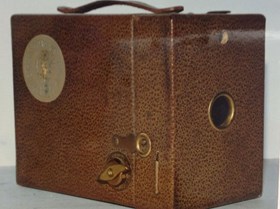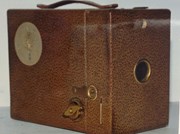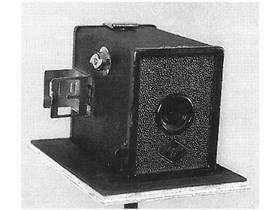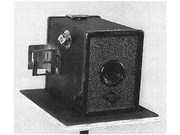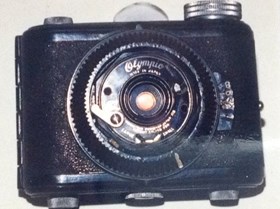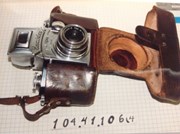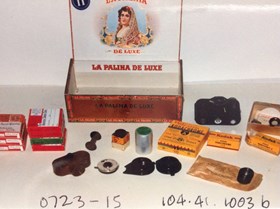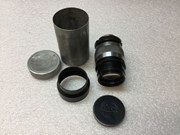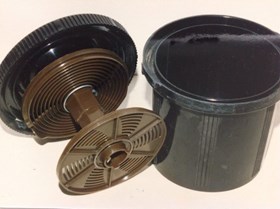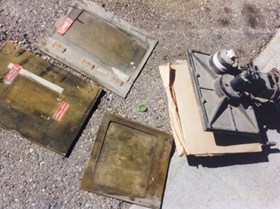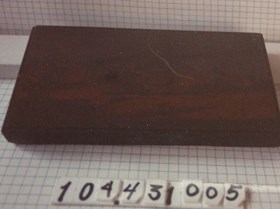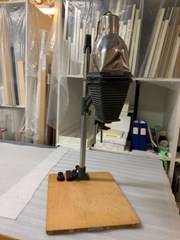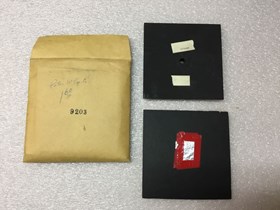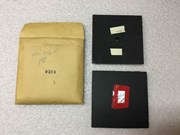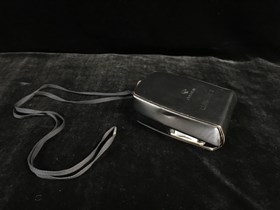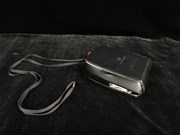Narrow Results By
- Date
- 1930 – 1940
- Material
- cardboard, leatherette; glass, metal;
- Catalogue Number
- 104.41.1053
- Description
- Kodak Anniversary box camera; brown, textured leather covered cardboard for body; leather strap on top;viewfinder window; body back clip top; viewfinder lens; internal lens front; body back clip; shutter release; film advance; foil decal commemorating 50th Anniversary on side; amber window at back.
1 image
- Title
- Box Camera
- Date
- 1930 – 1940
- Material
- cardboard, leatherette; glass, metal;
- Dimensions
- 14.7 x 11.1 x 8.4 cm
- Description
- Kodak Anniversary box camera; brown, textured leather covered cardboard for body; leather strap on top;viewfinder window; body back clip top; viewfinder lens; internal lens front; body back clip; shutter release; film advance; foil decal commemorating 50th Anniversary on side; amber window at back.
- Subject
- photography
- Credit
- Gift of Robert N. Smith, Canmore, 1985
- Catalogue Number
- 104.41.1053
Images
This material is presented as originally created; it may contain outdated cultural descriptions and
potentially offensive content.
Read more.
- Date
- 1938
- Material
- metal; glass; paper
- Catalogue Number
- 104.41.1113 a,b
- Description
- A simple black box camera with black, simulated textured leather. It also has an adhesive-taped, original box. The inverted aperture in the front has a black metal retention ring surrounding it. Below this “Agfa” is imprinted on the camera, surrounded by a diamond-shaped box. There is a black metal…
1 image
- Title
- Box Camera
- Date
- 1938
- Material
- metal; glass; paper
- Dimensions
- 8.5 x 6.5 cm
- Description
- A simple black box camera with black, simulated textured leather. It also has an adhesive-taped, original box. The inverted aperture in the front has a black metal retention ring surrounding it. Below this “Agfa” is imprinted on the camera, surrounded by a diamond-shaped box. There is a black metal rim which overlaps the edges on the front of the camera; on both sides there is a slight extension, .03 x.05 wide, 2.0cm from the top, with a hole in the metal. This fits over two small metal knobs on each side of the camera body. It appears that pushing the knobs in and pulling, would release the front part of the camera from the body. On the viewer’s left is the metal shutter release; a small metal lever that can be pulled down to release the shutter and expose the lens from inside the body. On the same side is the metal film winder, 3.0cm from the front and .50cm from the top; this is a flat piece of metal 2.0cm in diameter, with arrows indicating the direction to turn (clockwise arrows), a round raised metal tab, onto which is screwed a piece of metal (2.5cmx1.0cm wide in the middle) to wind the film. It can also be pulled out to release the metal film chamber. The metal is turned down on the side of each end so the fingers can grasp it for turning. A metal folding viewfinder is .50cm from the back and 2.7cm from top and bottom; a flat piece of metal 3.0cm sq., folded at the sides, is rivetted onto the body. Two flat metal pieces are attached at each end, one on a spring to fold down; this piece is 2.4x2.7cm wide with a window cut out .50x1.0cm wide. The other piece is 2.7cm sq. with a window of 1.5x2.4cm wide; the cutout has a piece of metal raised from the bottom of the window. The cutout is for perspective when you look through the viewfinder, vertically or horizontally. This piece of metal folds down to become the top, effectively making the viewfinder flat when not in use. There is a hinged door on the back of the camera and a cut-out metal latch on the door that connects to a small metal knob 1.0cm from the edge of the body. There is a red circle film window (1.0cm diagonally) which lets you read the frame number on the film. On the inside of the door are two rivets that connect the hinge. Above that and below the red circle, is a white painted circle with “USE AB” printed in black, overlapping a painted orange, blue, white, and yellow Agfa Plenachrome film box. The red viewfinder is 4.0cm from the base. A metal film chamber, with two metal rollers on each end for winding the film on, fits inside the camera. It can be released by pulling out the film winder. The canister is 7.0x5.0 wide, is open at one end, hollow in the centre, sloping upwards with a circular hole at the other end to let light in. There are two sprockets sitting on two cutouts on top of the canister and two on the bottom, onto which the film is winded. There are two rivets attaching two Y-shaped metal pieces, on either end that guide and let the film move and roll. The top of the camera has two metal knobs 1.5cm crosswise from each end, where a leather strap with a hole on either end, .07cm from the edge, fits in to make a diagonal strap/handle for carrying. The strap is imprinted with “A-8 CADET”. There is a small metal pull-up tab, 1.0cm from the edge of the front of the camera, that lets you time the shutter speed.
- Subject
- households
- photography
- hobbies
- Bob Louden
- Credit
- Gift of Bob Louden, Calgary, 2004
- Catalogue Number
- 104.41.1113 a,b
Images
This material is presented as originally created; it may contain outdated cultural descriptions and
potentially offensive content.
Read more.
- Date
- 1930 – 1950
- Material
- metal, glass, leather
- Catalogue Number
- 104.41.1026
- Description
- miniature camera, case and film; black , die cast steel body; no glass; viewfinder, chrome lens; filmadvance; body back latch; empty film spool inside; brass with steel ends;"Belgium" stamp on either steel end; small red window on camera back; "TSLULCA" marked on lens front; leather case (16.7 x 8.…
1 image
- Title
- Camera
- Date
- 1930 – 1950
- Material
- metal, glass, leather
- Dimensions
- 3.8 x 5.7 x 4.3 cm
- Description
- miniature camera, case and film; black , die cast steel body; no glass; viewfinder, chrome lens; filmadvance; body back latch; empty film spool inside; brass with steel ends;"Belgium" stamp on either steel end; small red window on camera back; "TSLULCA" marked on lens front; leather case (16.7 x 8.5 x 8.2); zipper "Japan"stamped on leather; 2 rolls "ULCA Film" 8 exposure; made in Belgium; pinkcontainer with screws, glass discs, dial with "T B I" stamped onto surface.
- Subject
- photography
- Dr. Kennedy
- Credit
- Gift of Ernest Kennedy, 1968
- Catalogue Number
- 104.41.1026
Images
This material is presented as originally created; it may contain outdated cultural descriptions and
potentially offensive content.
Read more.
- Date
- 1930 – 1950
- Material
- metal, glass
- Catalogue Number
- 104.41.1025
- Description
- vest camera, Olympic; black, bakelite body; hinged back; release is small chrome button opposite hinge; chrome dials top and bottom; tripod mount; distance guide beside lensfocus ring; "Olympic" RODENSTEIN PERISKOP JAPAR 1:8" with large small lever inbetween, on lens; (lens is detached); 2 small or…
1 image
- Title
- Camera
- Date
- 1930 – 1950
- Material
- metal, glass
- Dimensions
- 4.3 x 9.1 x 7.4 cm
- Description
- vest camera, Olympic; black, bakelite body; hinged back; release is small chrome button opposite hinge; chrome dials top and bottom; tripod mount; distance guide beside lensfocus ring; "Olympic" RODENSTEIN PERISKOP JAPAR 1:8" with large small lever inbetween, on lens; (lens is detached); 2 small orange coloured windows on bodyblack steel spool inside. Made in Japan.
- Subject
- photography
- Dr. Kennedy
- Credit
- Gift of Ernest Kennedy, 1968
- Catalogue Number
- 104.41.1025
Images
This material is presented as originally created; it may contain outdated cultural descriptions and
potentially offensive content.
Read more.
- Date
- prior to 1991
- Material
- metal; plastic
- Catalogue Number
- 104.41.0254
- Description
- An Eastman Kodak Co. Camera , found in an avalanche slope behind Mount Edith on June 15 1991. The camera looks burnt, it is completely grey and rusted, many pieces are broken. It is housed in a Ziploc bag which catches the rust and corroded metal. There is still a roll of film in the camera.
1 image
- Title
- Camera
- Date
- prior to 1991
- Material
- metal; plastic
- Dimensions
- 6.8 x 11.5 x 5.1 cm
- Description
- An Eastman Kodak Co. Camera , found in an avalanche slope behind Mount Edith on June 15 1991. The camera looks burnt, it is completely grey and rusted, many pieces are broken. It is housed in a Ziploc bag which catches the rust and corroded metal. There is still a roll of film in the camera.
- Subject
- photography
- camera
- avalanche
- found item
- Mount Edith
- Credit
- Gift of Adrian Phillips, Calgary, 1991
- Catalogue Number
- 104.41.0254
Images
This material is presented as originally created; it may contain outdated cultural descriptions and
potentially offensive content.
Read more.
- Date
- 1976 – 1981
- Material
- metal; plastic; glass
- Catalogue Number
- 104.41.0256
- Description
- A small-sized, black and silver mechanical camera by Agfa. The top of the camera features text that reads “tele” “AGFAMATIC 2008” “sensor”, on the right side is a large red button which release the shutter [this is a unique characteristic to Agfa cameras during this period] with a metal ring around…
1 image
- Title
- Camera
- Date
- 1976 – 1981
- Material
- metal; plastic; glass
- Dimensions
- 2.5 x 11.7 x 5.3 cm
- Description
- A small-sized, black and silver mechanical camera by Agfa. The top of the camera features text that reads “tele” “AGFAMATIC 2008” “sensor”, on the right side is a large red button which release the shutter [this is a unique characteristic to Agfa cameras during this period] with a metal ring around it, above the shutter release is two switches, one switch features symbols of a cloud and sun and the other switch features a small arrow when slide right it’ll point to “tele”. On the right side of the camera is a metal chain wrist strap. The back of the camera, where the viewfinder is, is narrow and features the viewfinder on the left side (on the silver part) and a clear window with to see into where the film is loaded with text that reads “AGFACOLOUR 110”. To load the camera there is another slide switch near the top of the back that release the panel. On the bottom of the camera is one slide switch that when slid to the left releases the silver part of the camera to reveal the viewfinder and allows the user to photograph. After each exposure the user slides the silver mechanism back into the black body of the camera [this is how the film advances]. The front of the camera features branding, from left to right the text reads “AGFAMATIC 2008” “tele pocket” “Agfa” in cursive font inside a diamond. When the camera is ready to use the front of the camera reveals the lens with white text that reads “COLOR AGNAR” and the viewfinder, on the back the viewfinder is useable.
- Subject
- film photography
- camera
- photography
- Whyte
- Whyte Home
- Credit
- Gift of Catharine Robb Whyte, O. C., Banff, 1979
- Catalogue Number
- 104.41.0256
Images
This material is presented as originally created; it may contain outdated cultural descriptions and
potentially offensive content.
Read more.
- Date
- 1930 – 1940
- Material
- metal; glass; skin
- Catalogue Number
- 104.41.1064
- Description
- One Jhagee Exakta SLR 35mm with a leather case. This metal camera is built for a left-handed user.
1 image
- Title
- Camera
- Date
- 1930 – 1940
- Material
- metal; glass; skin
- Description
- One Jhagee Exakta SLR 35mm with a leather case. This metal camera is built for a left-handed user.
- Subject
- Byron Harmon
- photography
- Credit
- Gift of Jim Davies, Banff, 1991
- Catalogue Number
- 104.41.1064
Images
This material is presented as originally created; it may contain outdated cultural descriptions and
potentially offensive content.
Read more.
Camera Accessories
https://archives.whyte.org/en/permalink/artifact104.41.1003%20b
- Date
- 1930 – 1950
- Material
- metal, glass, paper, leather
- Catalogue Number
- 104.41.1003 b
- Description
- 2 cigar boxes containing miscellaneous camera accessories:box b: wooden box "La Palina deluxe"; 7 boxes "Univex" 8 mm motion picturefilm; 3 developed, 4 unexposed; 1 box "Kodachrome" 16 mm motion picture film,unopened; 1 box "Verichrome" unopened; 1 box "Panchromatic-X" opened,unexposed; diaphragm …
1 image
- Title
- Camera Accessories
- Date
- 1930 – 1950
- Material
- metal, glass, paper, leather
- Dimensions
- 7.0 x 14.1 x 23.1 cm
- Description
- 2 cigar boxes containing miscellaneous camera accessories:box b: wooden box "La Palina deluxe"; 7 boxes "Univex" 8 mm motion picturefilm; 3 developed, 4 unexposed; 1 box "Kodachrome" 16 mm motion picture film,unopened; 1 box "Verichrome" unopened; 1 box "Panchromatic-X" opened,unexposed; diaphragm and shutter apparatus; silver film container, negativesinside; green label "Superpan"; black film in cut up box; film spool "Pathe"film strip viewer; filmstrip included; 2 green filters with lever; small boxwith circle cut one side, square with ground glass, circular box with squarecut, ground glass taped on; small lens in paper envelope; box withmiscellaneous parts; viewfinders, screws, washers, etc.
- Subject
- photography
- Dr Kennedy
- Credit
- Gift of Ernest Kennedy, 1968
- Catalogue Number
- 104.41.1003 b
Images
This material is presented as originally created; it may contain outdated cultural descriptions and
potentially offensive content.
Read more.
- Date
- 1971 – 1973
- Material
- wood; metal; plastic; paper; leather;
- Catalogue Number
- 104.41.0154 a-e
- Description
- Wooden case with buffer runners on the front, back, and along the bottom - the hinged lid has a leather handle and is held closed with two small screws. Throughout the exterior are various shipping stickers, usually from CP Rail, “34” is stenciled on all sides, and a wooden name plate with Nicholas…
1 image
- Title
- Camera Case
- Date
- 1971 – 1973
- Material
- wood; metal; plastic; paper; leather;
- Dimensions
- 30.0 x 36.5 x 40.5 cm
- Description
- Wooden case with buffer runners on the front, back, and along the bottom - the hinged lid has a leather handle and is held closed with two small screws. Throughout the exterior are various shipping stickers, usually from CP Rail, “34” is stenciled on all sides, and a wooden name plate with Nicholas Morant’s information is nailed to the lid. Morant’s information is also stamped in red ink on the inside of the lid, along with a Linhof sticker.Inside the case is a Linhof Aero Technika camera - a camera used in aerial photography - as well as two bundles of Kodak gelatin filters in plastic bags, a viewfinder attachment housed in a black and yellow cardboard box, two plastic-frame Linhof filter attachments in individual fabric bags housed inside a cigar box, and two short hook links - one metal clasps attached by cord and one open hooks attached with a metal chain. The camera is housed inside a pale grey metal case that leaves the back exposed - the section of housing that extends over the lens can be removed, but has small openings throughout in order to access it - another opening along the top at the very front of the lens housing allows the plastic-framed filter to be slid in. On either side of the camera are large black plastic hand holds - the left side one has an extra leather strap that fits over the back of the hand. Fitted into the left-hand grip is a remote trigger.
- Credit
- Gift of Nicholas Morant, Banff, 2006
- Catalogue Number
- 104.41.0154 a-e
Images
This material is presented as originally created; it may contain outdated cultural descriptions and
potentially offensive content.
Read more.
Camera Equipment Case
https://archives.whyte.org/en/permalink/artifact104.41.0096%20a-g
- Date
- 1970 – 1985
- Material
- leather; wood; metal; fabric; plastic; glass
- Catalogue Number
- 104.41.0096 a-g
- Description
- Brown hard-sided travel case with metal caps on the corners, reinforcing along all edges, wooden runners parallel horizontally along the long sides of the case, and hinged lid with three metal clasps - the centre one has a keyhole. The interior of the case is divided into five compartments, the lar…
1 image
- Title
- Camera Equipment Case
- Date
- 1970 – 1985
- Material
- leather; wood; metal; fabric; plastic; glass
- Dimensions
- 31.0 x 30.2 x 59.5 cm
- Description
- Brown hard-sided travel case with metal caps on the corners, reinforcing along all edges, wooden runners parallel horizontally along the long sides of the case, and hinged lid with three metal clasps - the centre one has a keyhole. The interior of the case is divided into five compartments, the largest centre one has a false bottom accessed by a leather pull tab. There is a square of padding set into the centre of the lid, three equipment manuals are tucked into the right-hand side and the paper one is stuck. Inside the box is a 19.6x24.0x27.1 cm black box with a brown leather strap attached to the sides, a black leather handle on the lid, and a locking metal clasp on the hinged lid. This box is lined with blue velvet and contains various small pieces of camera equipment. Includes: power cord in a yellow fabric bag, micro screwdrivers in a yellow fabric bag, a metal and wood bracket in a white fabric bag, a “BRAUN” digital flash in a yellow fabric bag, an empty blue fabric bag, four metal Agfa film canisters (empty), assorted spacers and brackets, two keys (one in a paper envelope labelled “CASE KEY” in black ink), and various manuals in a plastic sleeve. Also inside the main case are two hard black lens cases - the larger one has a piece of masking tape on the bottom with “400” written in faded black ink and the smaller one has a piece of masking tape on the lid with “200” written in black ink - a metal and wood handle, a circular black plastic case with a black plastic lens cap inside, and a yellow filter in a clear plastic case. Both lens cases manufactured by “ASAHI OPT CO. JAPAN” as noted on the bottoms.
- Credit
- Gift of Nicholas Morant, Banff, 2006
- Catalogue Number
- 104.41.0096 a-g
Images
This material is presented as originally created; it may contain outdated cultural descriptions and
potentially offensive content.
Read more.
- Date
- 1975
- Material
- leather; metal; glass; fabric; plastic
- Catalogue Number
- 104.41.1281 a-e
- Description
- a) Asahi lens, black metallic cylinder engraved in white on top ring: “Super-Multi-Coated TAKUMAR / 6x7 1:3.5/55 5415794 / ASAHI OPT. CO., JAPAN”; screw mountedb) black plastic lens cap, textured on the top, labeled with with silver letters in relief encircling the brand logo: “TAKUMAR LENS FOR ASA…
1 image
- Title
- Camera Lens
- Date
- 1975
- Material
- leather; metal; glass; fabric; plastic
- Dimensions
- 12.5 cm
- Description
- a) Asahi lens, black metallic cylinder engraved in white on top ring: “Super-Multi-Coated TAKUMAR / 6x7 1:3.5/55 5415794 / ASAHI OPT. CO., JAPAN”; screw mountedb) black plastic lens cap, textured on the top, labeled with with silver letters in relief encircling the brand logo: “TAKUMAR LENS FOR ASAHI PENTAX / ASAHI OPT. CO., LTD.”c) black plastic screw mount cap with a red dot on the side, labeled with letters in relief: “TAKUMAR / ASAHI OPT. CO., JAPAN”d) original black leather cylindrical box, with shoulder strap attached by two eyelets; lid fastened by a press button on a strip; stamped at the top: “TAKUMAR 3.5/55 / FOR ASAHI PENTAX 6X7”; piece of white tape with handwritten “WA” in black in the centre; red velvet inside lininge) black round hard plastic box with ridged and textured lid with embossed label on the bottom: “TAKUMAR / ASAHI OPT. CO. JAPAN”
- Subject
- Nicholas Morant
- photography
- Credit
- Gift of Nicholas Morant, Banff, 2006
- Catalogue Number
- 104.41.1281 a-e
Images
This material is presented as originally created; it may contain outdated cultural descriptions and
potentially offensive content.
Read more.
- Date
- 1931 – 1942
- Material
- metal; glass;
- Catalogue Number
- 104.41.0214
- Description
- Ernst Leitz Wetzlar Hektor f=7,3 cm 1:1,9 lens with hood and lens cap in a metal tube case. The lens cap has Leica engraved on it - the case has the manufacturer name and the lens size stamped on the lid, which slides up off the tube.
1 image
- Title
- Camera Lens
- Date
- 1931 – 1942
- Material
- metal; glass;
- Dimensions
- 8.6 cm
- Description
- Ernst Leitz Wetzlar Hektor f=7,3 cm 1:1,9 lens with hood and lens cap in a metal tube case. The lens cap has Leica engraved on it - the case has the manufacturer name and the lens size stamped on the lid, which slides up off the tube.
- Credit
- Gift of Catharine Robb Whyte, O. C., Banff, 1979
- Catalogue Number
- 104.41.0214
Images
This material is presented as originally created; it may contain outdated cultural descriptions and
potentially offensive content.
Read more.
- Date
- 1930 – 1949
- Material
- wood; metal; plastic
- Catalogue Number
- 104.41.0100
- Description
- Wood and metal Thalhammer camera tripod with metal spikes at the end of the legs, brackets at various points along the legs, and camera mount. The tripod is retracted to its shortest setting, but can double in height. Each leg has an adjustable metal bracket with circular knobs on the outside of th…
1 image
- Title
- Camera Tripod
- Date
- 1930 – 1949
- Material
- wood; metal; plastic
- Dimensions
- 88.8 cm
- Description
- Wood and metal Thalhammer camera tripod with metal spikes at the end of the legs, brackets at various points along the legs, and camera mount. The tripod is retracted to its shortest setting, but can double in height. Each leg has an adjustable metal bracket with circular knobs on the outside of the leg - the flat part of the knob features a kneeling man holding the handle of a long hammer in front of him, with his hands above his head just below the head of the hammer. This same logo is featured throughout other metal pieces around the head of the tripod. A plastic-handled grip is attached to the top of the tripod. Four circular pieces of paper screwed onto the camera support base, possibly as spacers, upon removal the Thalhammer company information is shown.
- Credit
- Gift of Nicholas Morant, Banff, 2006
- Catalogue Number
- 104.41.0100
Images
This material is presented as originally created; it may contain outdated cultural descriptions and
potentially offensive content.
Read more.
Colour Filters
https://archives.whyte.org/en/permalink/artifact104.41.0112
- Date
- 1975 – 1989
- Material
- plastic; paper
- Catalogue Number
- 104.41.0112
- Description
- One dark purple and clear yellow plastic box containing five different coloured filters, instruction manual, and a red fabric cloth. The lid is attached to the body of the box with a strip of clear tape.DuPont de Nemours, Inc. developed various chemicals and polymers throughout the 19th and 20th ce…
1 image
- Title
- Colour Filters
- Date
- 1975 – 1989
- Material
- plastic; paper
- Dimensions
- 8.2 x 5.3 x 7.3 cm
- Description
- One dark purple and clear yellow plastic box containing five different coloured filters, instruction manual, and a red fabric cloth. The lid is attached to the body of the box with a strip of clear tape.DuPont de Nemours, Inc. developed various chemicals and polymers throughout the 19th and 20th centuries. The box contains “plastic FILTERS for VARIGAM PAPER” used during the development of photographs. Each filter is numbered 1-10, but 5 are missing leaving only 1, 3, 5, 7, and 10.
- Credit
- Gift of Nicholas Morant, Banff, 2006
- Catalogue Number
- 104.41.0112
Images
This material is presented as originally created; it may contain outdated cultural descriptions and
potentially offensive content.
Read more.
Developing Tank
https://archives.whyte.org/en/permalink/artifact104.41.1059
- Date
- 1930 – 1950
- Material
- plastic
- Catalogue Number
- 104.41.1059
- Description
- Black plastic developing tank; black plastic cylinder with detachable lid; 6 groups of 4 ridges running the height of cylinder; lip surrounding opening at top; "PLANO" printed in relief on lid; 2 oblong holes to correspond to tongues on bottom section; olive colour spool with near spaced thread att…
1 image
- Title
- Developing Tank
- Date
- 1930 – 1950
- Material
- plastic
- Dimensions
- 12.0 x 12.4 cm
- Description
- Black plastic developing tank; black plastic cylinder with detachable lid; 6 groups of 4 ridges running the height of cylinder; lip surrounding opening at top; "PLANO" printed in relief on lid; 2 oblong holes to correspond to tongues on bottom section; olive colour spool with near spaced thread attached to lid with finger knob coming through to outside.
- Subject
- photography
- Credit
- Gift of Robert N. Smith, Canmore, 1985
- Catalogue Number
- 104.41.1059
Images
This material is presented as originally created; it may contain outdated cultural descriptions and
potentially offensive content.
Read more.
Dry Mounting Press
https://archives.whyte.org/en/permalink/artifact104.41.1067
- Date
- prior to 1950
- Material
- metal
- Catalogue Number
- 104.41.1067
- Description
- Metal press with handle, electrical cord (220). Three brass hinged mounting plates, 3 sizes.
1 image
- Title
- Dry Mounting Press
- Date
- prior to 1950
- Material
- metal
- Description
- Metal press with handle, electrical cord (220). Three brass hinged mounting plates, 3 sizes.
- Subject
- photography
- Byron Harmon
- Credit
- Gift of Don Harmon, Banff, 1994
- Catalogue Number
- 104.41.1067
Images
This material is presented as originally created; it may contain outdated cultural descriptions and
potentially offensive content.
Read more.
Engraving Plate
https://archives.whyte.org/en/permalink/artifact104.43.1005
- Date
- 1930 – 1970
- Material
- wood; metal, copper
- Catalogue Number
- 104.43.1005
- Description
- A rectangle of wood with a metal plate attached. The copper plate has an image on it.This item was transferred to the Archives by SS in May/June 2014.
1 image
- Title
- Engraving Plate
- Date
- 1930 – 1970
- Material
- wood; metal, copper
- Description
- A rectangle of wood with a metal plate attached. The copper plate has an image on it.This item was transferred to the Archives by SS in May/June 2014.
- Subject
- photography
- Credit
- Gift of Arthur Oliver Wheeler, 1975
- Catalogue Number
- 104.43.1005
Images
This material is presented as originally created; it may contain outdated cultural descriptions and
potentially offensive content.
Read more.
- Date
- 1930 – 1950
- Material
- wood; metal; plastic; glass;
- Catalogue Number
- 104.41.0163
- Description
- Metal Kodak Precision Enlarger mounted on a wooden board with power outlets and power switch mounted beside the base of the enlarger. The support arm mostly consists of a silver metal pole onto which the dull grey metal enlarger support is mounted - a plastic knob on one side allows the enlarger su…
1 image
- Title
- Enlarger
- Date
- 1930 – 1950
- Material
- wood; metal; plastic; glass;
- Dimensions
- 105.0 x 44.5 x 55.7 cm
- Description
- Metal Kodak Precision Enlarger mounted on a wooden board with power outlets and power switch mounted beside the base of the enlarger. The support arm mostly consists of a silver metal pole onto which the dull grey metal enlarger support is mounted - a plastic knob on one side allows the enlarger support to move up and down the support arm. The enlarger itself consists of a shiny metal dome with a fabric-wrapped power cord coming out the top [most likely the house for the light source] mounted on top of the grey metal frame [to which the enlarger support is attached] and into which several different negative trays can be fit, below the frame are dark grey fabric bellows that can be adjusted along a set of metal poles, the bottom of the bellows are attached to a smaller grey metal frame that also houses the focussing lens and a coloured filter that can be rotated in and out of frame.
- Subject
- Nicholas Morant
- photography
- photograph equipment
- camera equipment
- darkroom
- photograph developing;
- Credit
- Gift of Nicholas Morant, Banff, 2006
- Catalogue Number
- 104.41.0163
Images
This material is presented as originally created; it may contain outdated cultural descriptions and
potentially offensive content.
Read more.
- Date
- 1930 – 1960
- Material
- paper; cardboard; wood;
- Catalogue Number
- 104.51.1003
- Description
- Square manilla envelope with one wooden square and one cardboard square with unknown purposes inside. The envelope has “Peter Whyte” written in cursive above “1.60” written in pencil - “9203” is stamped in black in the middle. The wooden square has a hole drilled in the middle and angled edges, mak…
1 image
- Title
- Envelope
- Date
- 1930 – 1960
- Material
- paper; cardboard; wood;
- Dimensions
- 0.5 x 11.9 x 11.9 cm
- Description
- Square manilla envelope with one wooden square and one cardboard square with unknown purposes inside. The envelope has “Peter Whyte” written in cursive above “1.60” written in pencil - “9203” is stamped in black in the middle. The wooden square has a hole drilled in the middle and angled edges, making one side a slightly smaller square than the other, and there are two small pieces of white adhesive tape, one of which has random letters and numbers typed on it [possibly a spacer for a tripod]. The cardboard square has a small hole poked in the middle and blocked off on one side with what appears to be tinfoil taped down with several layers of red adhesive tape.
- Subject
- photography
- Peter Whyte;
- Credit
- Gift of Catharine Robb Whyte, O. C., Banff, 1979
- Catalogue Number
- 104.51.1003
Images
This material is presented as originally created; it may contain outdated cultural descriptions and
potentially offensive content.
Read more.
- Date
- 1933 – 1949
- Material
- plastic; paint; leather; metal; fabric
- Catalogue Number
- 104.41.1123 a-b
- Description
- (a)Gossen Lunasix exposure and colour meter in a pear shape with leather case. The light meter device measures the amount of light that is appropriate to achieve the proper exposure, indicating for the users which shutter speed and f-number should be selected. Along the top of the exposure meter in…
1 image
- Title
- Exposure Meter
- Date
- 1933 – 1949
- Material
- plastic; paint; leather; metal; fabric
- Dimensions
- (a)2.5; (b)04.5 x (a)6.5; (b)7.5 x (a)11.5; (b)12.0 cm
- Description
- (a)Gossen Lunasix exposure and colour meter in a pear shape with leather case. The light meter device measures the amount of light that is appropriate to achieve the proper exposure, indicating for the users which shutter speed and f-number should be selected. Along the top of the exposure meter in the viewer left corner is a white bulb-like part next to an open circular window that measures the amount of light present in the scene. When the converter slide, located along the viewer right side, is moved to the right and clicked into position the round window is open and ready to read the scene. At the top, on the face of the meter, the light measurement (scale) is present. This shows how much light is present in the scene and directly relates to the remaining scales on the meter. Below the light scale is a plexiglass film-speed setting disc with grooves that allow the operator to easily move the dial. In the middle of the dial there is the Lunasix manufacturer symbol. On viewer left side of this emblem is the DIN exposure index of the film in use; on the proper right side of this emblem is the ASA exposure index of the film in use. By moving the dial one adjusts the film-speed setting, which is indicated in the DIN and ASA boxes, whereby the index number is lined up against the triangular white marker in the respective window. A manual would have originally been sold with the object giving a more comprehensive overview of the film-speed table with a technical appendix. On the rear of the object in the viewer right corner one will see the correct position of the 2 batteries indicated through a tiny diagram. Below this is a metal battery chamber. Below this are the words “2 Batt. Mallory” “PX 625 o. PX 13”. To the viewer left of this writing is the ridged slide used for battery testing. Above the ridged slide are the words “Batt. Contr.” with a solid arrow below. Below the battery information is the table of footcandle (LUX) equivalents. In the middle of the table is the zero adjustable screw with an arrow pointing in both directions. AT the very bottom painted on the surface is the location of manufacturing; “GERMANY (WEST)” above a cutout window revealing the patent number; “4D01673”. (b) There is also a black leather case with the object. The inside of the case has gray suede lining, which would have helped avoid scratching and marking of the meter. The case has been carefully designed to retrofit the meter, which is apparent through the tiny leather strap present when the case is opened. These designs allow the object to be formly held into place further safeguarding it. At the bottom of the case there is a black button that allows the case to be opened and fastened shut. When the case is fastened shut, the name of the manufacturer “Gossen” appears imprinted and is upside down. Below this, also upside down, “LUNASIX 3” has been applied in silver ink. Along the viewer right side the case has a cutout that perfectly fit the converter slide. On the rear “MADE IN GERMANY” appears in a receded box with protruding lettering. The bottom of the case, where the button is located, contains an opening for the black string to be strung through. The string, which has been tied to the exposure meter, measures 49.0 cm and has a metal piece holding the ends of the string in place. This would have given the user greater security when working with the exposure meter.
- Subject
- photography
- Nick Morant
- Credit
- Gift of Nicholas Morant, Banff, 2006
- Catalogue Number
- 104.41.1123 a-b
Images
This material is presented as originally created; it may contain outdated cultural descriptions and
potentially offensive content.
Read more.

